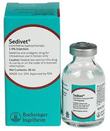Pronunciation
ro-MIF-ih-deen - Pronunciation guide
Brand Names
- Sedivet 1% Injection
Description
 Romifidine is a newer tranquilizer or sedative that has been available in Europe for some time, but has been marketed in the U.S. only recently. Romifidine is from the same chemical family as xylazine and detomidine. Romifidine is effective for longer periods, and horses appear less ataxic or wobbly when this drug is used, in comparison to horses given xylazine or detomidine. When combined with butorphanol, it is effectively used in pain management.
Romifidine is a newer tranquilizer or sedative that has been available in Europe for some time, but has been marketed in the U.S. only recently. Romifidine is from the same chemical family as xylazine and detomidine. Romifidine is effective for longer periods, and horses appear less ataxic or wobbly when this drug is used, in comparison to horses given xylazine or detomidine. When combined with butorphanol, it is effectively used in pain management.
Usage
Romifidine is used as a tranquilizer or sedative by veterinarians during radiographs or lameness examinations. It is also used as a pre-anesthetic drug to calm the horse before injectable or gas inhalation anesthesia is given. Combined with butorphanol, it is often used in pain management.
Dosage and Administration
 Romifidine Romifidine |
||||
|---|---|---|---|---|
| Method | Dosage (click row for calculator) |
Concentration | Period | Duration |
| Sedation and analgesia dose | ||||
| Intravenous injection (slow) | 0.04-0.120 mg/kg | 10 mg/ml | Treatment | NA |
| Preanesthesia dose | ||||
| Intravenous injection (slow) | 0.1 mg/kg | 10 mg/ml | Treatment | NA |
Notes:
|
||||
Side Effects
Common side effects are a slowing of the heart rate and a change in heart rhythm in some horses. Romifidine causes a decrease in gastrointestinal motility and mild colic has been observed after use.
Precautions
Romifidine should not be used in horses with abnormal heart rhythms or heart disease and should be used with extreme caution in horses that have major health problems, including shock, severe respiratory disease, or severe liver and kidney problems.
On rare occasions, an individual horse may respond to the drug with excitement instead of the usual sedated effect.
Horses may drop their heads and appear very sedate. Some loss of coordination and sweating are common. Horses can act suddenly and unexpectedly when given sedatives and caution should be taken at all times when working around a sedated horse.
Romifidine reduces the horse's body's ability to regulate temperature.
Romifidine is FDA-approved for use in horses and is a prescription drug restricted to use by or on the lawful written or oral order of a licensed veterinarian.
Romifidine is a prohibited substance in most sanctioned competitions. It is important to check with the individual regulatory group.
Interactions
Romifidine has additive effects when combined with other tranquilizers or anesthetic drugs and should be used only by veterinarians who are experienced with the use of these drugs.
Trimethoprim sulfa should not be used in horses sedated with romifidine.
Chloramphenicol can interfere with the metabolism of alpha-2-agonist drugs, such as romifidine.
Overdose
Overdose causes heart arrhythmias, low blood pressure, and respiratory and central nervous system depression. Yohimbine can be used to reverse some of the effects of romifidine.
Images
 Sedivet Romifidine Injection
Sedivet Romifidine Injection
Literature
